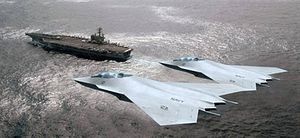The U.S. Navy and Air Force agreed to jointly work on a next generation air superiority fighter with multirole capabilities and the ability to execute manned and unmanned missions, Kris Osborne over at military.com reports.
According to Rear Admiral Michael Manazir, the U.S. Navy’s Director of Air Warfare:
There is an opportunity to field an unmanned system in the F/A XX program. We are collaborating with the Air Force on the technologies that would be required to operate an air system that gives us enhanced capabilities in the future.
The new aircraft, named the F/A XX, is meant to start replacing the majority of the United States Navy’s F/A-18 Super Hornet and EA-18G Growler aircraft by 2035. The F/A XX is also intended supplement the F-35C Lighting II and the UCLASS unmanned aerial vehicle.
U.S. military officials stress that the work is purely conceptual at this stage and that no platform has yet be identified. UNSI News reports that the U.S. Navy’s Fiscal Year 2016 budget allocated $ 5 million to start early conceptual work on the next generation fighter.
Major General Paul Johnson, the Deputy Chief of Staff, Requirements, of the U.S. Air Force tells military.com:
We are actively engaged with the Navy on the capabilities required to achieve air superiority to 2030 and beyond. As always, we’ll need the capability to sense and characterize the battlespace, then command and control platforms and weapons, all while surviving. As of right now, that does not translate to a next-gen fighter.
In an earlier interview with USNI News, Manazir also cautioned that it still too early to speculate about the precise characteristics and shape of the new platform:
So what we would look at is everything — from an airframe, to a family of systems, to continuing something we already have flying, to capabilities that we already have in the air wing or the joint world — to asses what we really need to replace the Super Hornet.
Whatever the new platform will be, it must have the capability of operating from Navy Nimitz-class and Gerald R. Ford-class aircraft carriers.
Interestingly, back in February 2015, the Chief of Naval Operations (CNO), Admiral Jonathan Greenert, hinted that the F/A XX might be much less stealthier than previous air superiority fighters:
You know that stealth may be over-rated, I don’t want to necessarily say that it’s over but let’s face it, if something moves fast through the air and disrupts molecules in the air and puts out heat – I don’t care how cool the engine can be – it’s going to be detectable.
The armament of the F/A XX, aside from missiles, might also include hypersonic and cyber weapons. The plane might also use cutting-edge engine technologies like scramjets and electronically configured “smart skins.”
When the F/A XX will finally be ready in the 2030s, the U.S. Navy’s vision of its carrier-based naval air forces will be the following, according to Kris Osborne:
The Navy vision for a future carrier air wing in 2040 and beyond is comprised of the carrier-launched variant of the Joint Strike Fighter, the F-35C, as the legacy aircraft alongside the EA-18G Growler electronic jamming aircraft and the yet-to-be built Unmanned Carrier Launched Airborne Surveillance and Strike platform, or UCLASS, a carrier-launched drone slated to arrive by 2025.

































